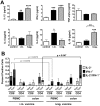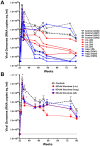Comparison of systemic and mucosal immunization with helper-dependent adenoviruses for vaccination against mucosal challenge with SHIV
- PMID: 23844034
- PMCID: PMC3701068
- DOI: 10.1371/journal.pone.0067574
Comparison of systemic and mucosal immunization with helper-dependent adenoviruses for vaccination against mucosal challenge with SHIV
Abstract
Most HIV-1 infections are thought to occur at mucosal surfaces during sexual contact. It has been hypothesized that vaccines delivered at mucosal surfaces may mediate better protection against HIV-1 than vaccines that are delivered systemically. To test this, rhesus macaques were vaccinated by intramuscular (i.m.) or intravaginal (ivag.) routes with helper-dependent adenoviral (HD-Ad) vectors expressing HIV-1 envelope. Macaques were first immunized intranasally with species C Ad serotype 5 (Ad5) prior to serotype-switching with species C HD-Ad6, Ad1, Ad5, and Ad2 vectors expressing env followed by rectal challenge with CCR5-tropic SHIV-SF162P3. Vaccination by the systemic route generated stronger systemic CD8 T cell responses in PBMC, but weaker mucosal responses. Conversely, mucosal immunization generated stronger CD4 T cell central memory (Tcm) responses in the colon. Intramuscular immunization generated higher levels of env-binding antibodies, but neither produced neutralizing or cytotoxic antibodies. After mucosal SHIV challenge, both groups controlled SHIV better than control animals. However, more animals in the ivag. group had lower viral set points than in in the i.m. group. These data suggest mucosal vaccination may have improve protection against sexually-transmitted HIV. These data also demonstrate that helper-dependent Ad vaccines can mediate robust vaccine responses in the face of prior immunity to Ad5 and during four rounds of adenovirus vaccination.
Conflict of interest statement
Figures






Similar articles
-
Combination Adenovirus and Protein Vaccines Prevent Infection or Reduce Viral Burden after Heterologous Clade C Simian-Human Immunodeficiency Virus Mucosal Challenge.J Virol. 2018 Jan 2;92(2):e01092-17. doi: 10.1128/JVI.01092-17. Print 2018 Jan 15. J Virol. 2018. PMID: 29093095 Free PMC article.
-
Divergent HIV-1-Directed Immune Responses Generated by Systemic and Mucosal Immunization with Replicating Single-Cycle Adenoviruses in Rhesus Macaques.J Virol. 2019 May 1;93(10):e02016-18. doi: 10.1128/JVI.02016-18. Print 2019 May 15. J Virol. 2019. PMID: 30842321 Free PMC article.
-
Mucosally-administered human-simian immunodeficiency virus DNA and fowlpoxvirus-based recombinant vaccines reduce acute phase viral replication in macaques following vaginal challenge with CCR5-tropic SHIVSF162P3.Vaccine. 2005 Oct 10;23(42):5009-21. doi: 10.1016/j.vaccine.2005.05.032. Vaccine. 2005. PMID: 15985317
-
The role of immunity in protection from mucosal SIV infection in macaques.Oral Dis. 2002;8 Suppl 2:63-8. doi: 10.1034/j.1601-0825.2002.00014.x. Oral Dis. 2002. PMID: 12164663 Review.
-
Mucosal immunity and protection against HIV/SIV infection: strategies and challenges for vaccine design.Int Rev Immunol. 2009;28(1):20-48. doi: 10.1080/08830180802684331. Int Rev Immunol. 2009. PMID: 19241252 Free PMC article. Review.
Cited by
-
A Simple and Versatile Method for Ex Vivo Monitoring of Goat Vaginal Mucosa Transduction by Viral Vector Vaccines.Vaccines (Basel). 2024 Jul 29;12(8):851. doi: 10.3390/vaccines12080851. Vaccines (Basel). 2024. PMID: 39203977 Free PMC article.
-
IIIa deleted adenovirus as a single-cycle genome replicating vector.Virology. 2014 Aug;462-463:158-65. doi: 10.1016/j.virol.2014.05.030. Epub 2014 Jul 2. Virology. 2014. PMID: 24996029 Free PMC article.
-
Vaginal delivery of vaccines.Adv Drug Deliv Rev. 2021 Nov;178:113956. doi: 10.1016/j.addr.2021.113956. Epub 2021 Sep 1. Adv Drug Deliv Rev. 2021. PMID: 34481031 Free PMC article. Review.
-
Comparison of the Life Cycles of Genetically Distant Species C and Species D Human Adenoviruses Ad6 and Ad26 in Human Cells.J Virol. 2015 Dec;89(24):12401-17. doi: 10.1128/JVI.01534-15. Epub 2015 Sep 30. J Virol. 2015. PMID: 26423951 Free PMC article.
-
Effects of Transportation and Relocation on Immunologic Measures in Cynomolgus Macaques (Macaca fascicularis).J Am Assoc Lab Anim Sci. 2019 Nov 1;58(6):774-782. doi: 10.30802/AALAS-JAALAS-19-000007. Epub 2019 Oct 11. J Am Assoc Lab Anim Sci. 2019. PMID: 31604484 Free PMC article.
References
-
- Lubeck MD, Natuk R, Myagkikh M, Kalyan N, Aldrich K, et al. (1997) Long-term protection of chimpanzees against high-dose HIV-1 challenge induced by immunization. Nat Med 3: 651–658. - PubMed
-
- Shiver JW, Fu TM, Chen L, Casimiro DR, Davies ME, et al. (2002) Replication-incompetent adenoviral vaccine vector elicits effective anti-immunodeficiency-virus immunity. Nature 415: 331–335. - PubMed
-
- Pinto AR, Fitzgerald JC, Giles-Davis W, Gao GP, Wilson JM, et al. (2003) Induction of CD8(+) T Cells to an HIV-1 Antigen through a Prime Boost Regimen with Heterologous E1-Deleted Adenoviral Vaccine Carriers. J Immunol 171: 6774–6779. - PubMed
Publication types
MeSH terms
Substances
Grants and funding
- AI065304/AI/NIAID NIH HHS/United States
- AI46969/AI/NIAID NIH HHS/United States
- R01 AI046969/AI/NIAID NIH HHS/United States
- AI42694/AI/NIAID NIH HHS/United States
- R01 HL083047/HL/NHLBI NIH HHS/United States
- AI06795/AI/NIAID NIH HHS/United States
- AI096967/AI/NIAID NIH HHS/United States
- R01 AI096967/AI/NIAID NIH HHS/United States
- HL083047/HL/NHLBI NIH HHS/United States
- DK067324/DK/NIDDK NIH HHS/United States
- R01 AI097241/AI/NIAID NIH HHS/United States
- R01 DK067324/DK/NIDDK NIH HHS/United States
- R01 AI065304/AI/NIAID NIH HHS/United States
- HHSN27201100016C/PHS HHS/United States
LinkOut - more resources
Full Text Sources
Other Literature Sources
Research Materials

